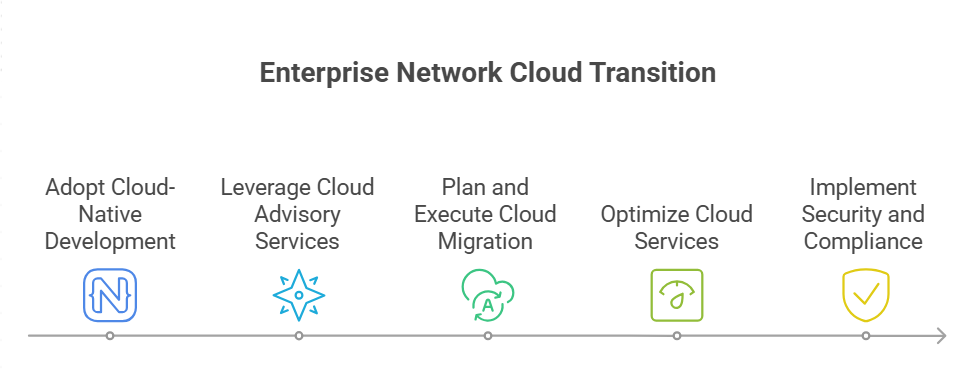Prepare Your Enterprise Network for the Cloud Era: Five Step Guide
Is your business ready to embrace the cloud in 2025? As cloud transformation continues to shape the future of industries worldwide, no company can afford to be left behind. With its unmatched scalability, flexibility, and cost-effectiveness, the cloud has become a key enabler for businesses striving to stay competitive. However, making the move to the cloud is not a simple decision. It’s a strategic, incremental journey that requires careful planning and consideration of your unique business needs and the complexities of your existing IT infrastructure.
This guide provides a clear, five-step roadmap to help you prepare your enterprise network for the cloud age. Whether you’re just starting out or looking to optimize your cloud strategy, each step focuses on a critical area of cloud adoption from development and migration to security and optimization. By the end, you’ll be equipped to navigate your cloud journey with confidence, leveraging cloud consulting services to ensure a seamless and successful transition.

1. Adopt Cloud-Native Development
What Is Cloud-Native Development?
Cloud-native development is a method of designing and deploying applications that fully leverage cloud computing. Unlike traditional monolithic applications, cloud-native applications are built based on microservices, containers, and orchestration tools. This enables the development of applications by organizations that are simpler to maintain, scalable, and fault-tolerant.
Cloud-native development adopts the “build once, deploy anywhere” pattern. This approach renders applications capable of operating smoothly on various cloud platforms and on-premises platforms, thus gaining maximum operational flexibility.
Key Benefits of Cloud-Native Development
- Scalability: Cloud-native apps can auto-scale to address peak requirements without endangering downtime and providing always-on performance.
- Resilience: With the applications broken down into smaller microservices, cloud-native systems are less likely to fail altogether. If a microservice fails, others are not affected and continue to function.
- Faster Deployment: With an agile approach using cloud-native development, businesses can deploy quick release cycles and refresh applications more frequently.
As the demand for agile, scalable, and high-performance apps keeps growing, cloud-native development is the most favored approach for businesses migrating to the cloud.
2. Leverage Cloud Advisory Services
Cloud advisory services are necessary to help businesses map their journey to the cloud. These services provide expert advice on deploying, designing, and implementing cloud solutions that are in line with your business strategy. Cloud advisors help analyze your current infrastructure, identify potential for the cloud, and create a strategic cloud adoption plan.
Why Cloud Advisory Services Matter
Cloud advisory services offer several essential benefits that can significantly assist in alleviating the complexity of the cloud adoption process:
- Strategic Alignment: Cloud advisors ensure that your cloud strategy aligns with your business objectives. They help you choose the right cloud model public, private, or hybrid that best matches your operation needs.
- Risk Mitigation: By analyzing your current infrastructure, cloud advisors can identify risks and provide suggestions to mitigate them so that the move to the cloud is smooth.
- Cost Optimization: A structured cloud strategy allows you to avoid over-allocation of resources and keep your costs in check so you pay only for what you consume.
Through collaboration with cloud specialists, organizations can be assured that not only do they implement cloud technologies but implement them to achieve maximum value and lowest risks.
3. Plan and Execute Cloud Migration
Cloud migration involves the shifting of applications, workloads, and data from on-premises infrastructure to the cloud. This is often one of the most challenging processes of cloud adoption, as it is planning and precise execution to ensure that it does not disrupt business activity. There are various ways to carry out cloud migration based on different requirements and priorities.
Different Cloud Migration Strategies
- Lift and Shift: It is a policy in which applications are moved to the cloud with minimal changes. It is typically the quickest and most convenient path, and thus it is the ideal option for firms that need to shift to the cloud without significant modification of their existing systems.
- Replatforming: Apps are moved to the cloud in this process with a bit of modification to take advantage of cloud-native features such as auto-scaling and better management of resources.
- Refactoring: The largest migration strategy where applications are rearchitected and refactored to leverage cloud-native capabilities to the fullest. It allows organizations to maximize cloud environments but requires the most effort and capital.
Successful migration requires an intimate understanding of your current systems, a clear migration plan, and the ability to test and optimize apps in the cloud.
4. Optimize Cloud Services for Performance and Cost
Once your applications and data are on the cloud, it’s important to monitor and fine-tune your cloud configuration from time to time. Cloud optimization is all about fine-tuning your infrastructure to improve performance as well as cost savings.
Performance Optimization
- Auto-Scaling: Cloud infrastructures come with auto-scaling functionality that automatically scales the number of resources allocated to an application based on the demand at the time. This implies your systems will handle increasing traffic without being allocated unnecessary resources.
- Performance Monitoring: Keeping cloud infrastructure in a constant check to discover performance bottlenecks and optimize workloads is essential. Using monitoring tools like cloud-native performance monitoring solutions can help you identify issues before they affect users.
Cost Optimization
Cloud services are usage-based, so cost optimization is essential while operating your cloud infrastructure. By monitoring usage habits and best practices in resource utilization, businesses can lower their cloud expenses exponentially without impacting performance.
Cost-optimization methods are:
Right-Sizing Resources: That resources such as virtual machines and storage are correctly sized up or down depending on the workload.
Reserved Instances Utilization: Organizations can reduce the cost of batch workloads by pre-paying long-term through reserved instances.
Cloud Cost Management Tools: The use of cloud vendor tools to track, manage, and optimize your cloud spend.
Having the right tools and processes in place, businesses can be confident they’re operating their cloud resources at maximum levels, not wasting money on unnecessary costs, and garnering optimal performance.
5. Implement Strong Security and Compliance Controls
Security and compliance are two of the most significant drivers of cloud adoption. Since there is more sensitive information going to the cloud, the right security protocols must be adopted so your firm’s data is not hacked and breached.
Key Cloud Security Practices
Data Encryption: Data in transit and data at rest encryption prevents sensitive information from falling into unauthorized hands, both when the data is residing in the cloud and during transit among users and systems.
Identity and Access Management (IAM): Proper IAM practices guarantee that only authorized users have the ability to be granted access to specific resources on the cloud platform. Multi-factor authentication (MFA) is one of the methods employed to augment security.
Monitoring and Auditing: Routine monitoring of your cloud infrastructure will be able to detect security threats and risks. In addition, audit trails are also able to provide information on user activity, which can detect and prevent unauthorized activity.
Compliance Frameworks
Companies also have to ensure their cloud rooms are compliant with industry standards like GDPR, HIPAA, or SOC 2. Having a compliance-first process in place ensures your company complies with legal and regulatory procedures and reduces the risk of penalties and lawsuits.
Cloud providers will probably provide a range of integrated services and tools to support companies in ensuring compliance but must remain active and adapt to emerging regulations.

Final Thoughts
The journey to the cloud might be complicated, but with the right strategy, companies can realize the numerous advantages offered by cloud computing. By embracing cloud-native development, having collaboration with cloud advisors, having an explicit migration plan, leveraging resources to the fullest for performance and costs, and incorporating strong security and compliance, your business network will be cloud-ready.
Start your cloud transformation now by seeking advice from experts to develop your very own cloud strategy that will propel your business into the future of the digital age.
FAQs
What is cloud-native development and why is it important for my business?
Cloud-native development enables businesses to build scalable and resilient applications using microservices and containers. App Maisters helps create cloud-native apps to keep your business competitive and flexible.
Why should I consider cloud advisory services from App Maisters?
App Maisters cloud advisory services align your cloud strategy with business goals, mitigating risks and optimizing costs for a smooth and efficient cloud transition.
How does App Maisters help with cloud migration?
App Maisters offers tailored cloud migration strategies, including lift and shift, replatforming, and refactoring, ensuring a seamless transition with minimal disruption.
How can App Maisters help optimize my cloud services for performance and cost?
App Maisters optimizes cloud performance and costs using auto-scaling, monitoring, and cost management tools to ensure your resources are used efficiently and cost-effectively.
How does App Maisters ensure cloud security and compliance for my business?
App Maisters ensures your cloud infrastructure follows best security practices like data encryption and IAM, while complying with standards like GDPR, HIPAA, and SOC 2.
What cloud platforms does App Maisters support for migration and optimization?
App Maisters supports cloud platforms like AWS, Azure, and Google Cloud, tailoring solutions to your needs for a smooth migration and optimization process.
How can App Maisters help with my cloud transformation journey?
App Maisters provides full support for cloud transformation, including consulting, migration, optimization, and security compliance, to ensure your business thrives in the cloud era.




















